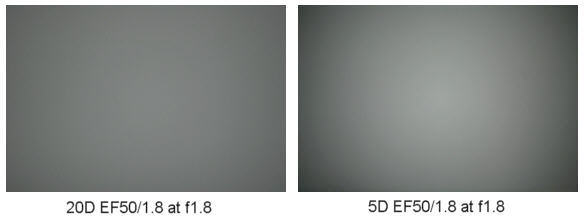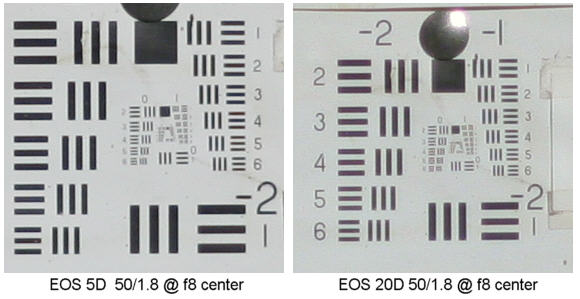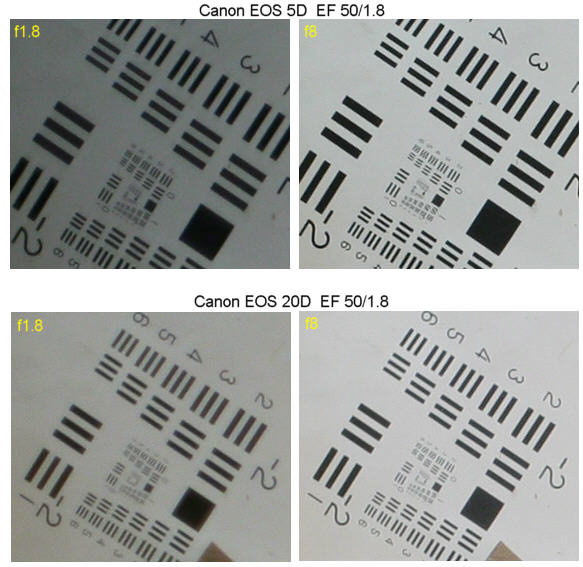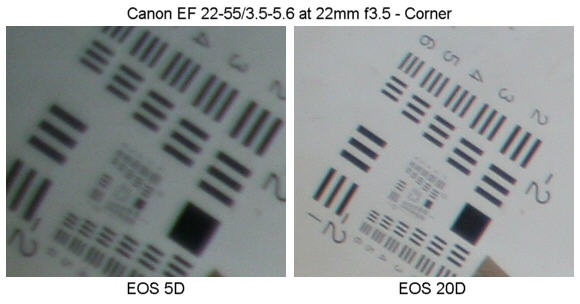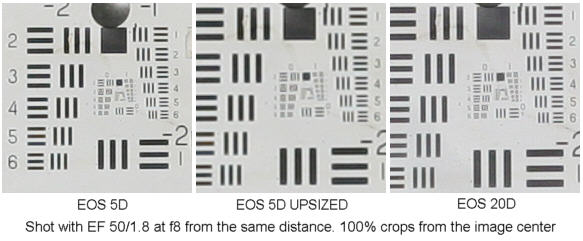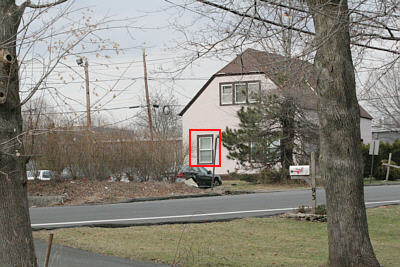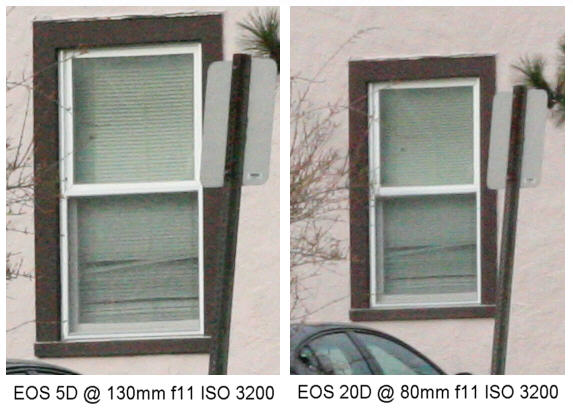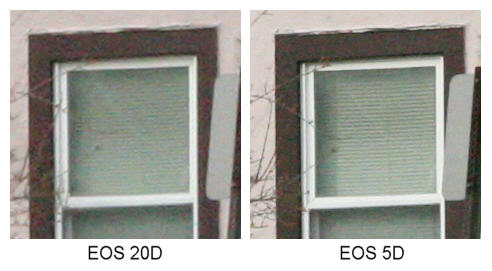
|
EOS 5D vs. EOS 20D - Full Frame vs. APS-C SensorsReal World TestingYou'd think that it would be easy to compare image quality from a EOS 5D (full frame) with a EOS 20D (APS-C), but really it isn't. There are maybe 4 ways you could do the test. [1] - You could use a different lens on each camera so as to give the same field of view. For example a 50/1.8 lens on the EOS 20D and an 85/1.8 lens on the EOS 5D would give you almost the same image in each case. However you'd then be testing the image quality of the two lenses as much as the image quality of the two sensors. [2] - You could use a zoom lens and equalize the field of view, so maybe you'd set the zoom to 50mm for the EOS 5D and 80mm for the EOS 20D. But then you'd be testing the image quality of the same lens at two different focal length settings. [3] - You could use the same lens on both cameras, but crop the image from the EOS 5D so it shows the same view as the EOS 20D, but then you're testing a cropped full frame image, which again isn't fair. [4] - Finally you could use the same lens on both cameras, but shoot from different distances. Say a 50mm lens shot at 10ft with the EOS 5D and 16ft with the EOS 20D. This is pretty fair since image quality is a very weak function of focus distance in this range. Of course it's not always practical in the real world. You can't usually back up from 1 mile to 1.6 miles when shooting a landscape for example! However for testing purposes, this seems to be about the best way to look at differences caused by the sensor. Vignetting
Well, the theoretical plot shown in the first part of this article seems to accurately describe what's seen in practice. Used wide open the full frame sensor shows significantly more vignetting as predicted. This will be worse with fast, wideangle lenses and better with slower, telephoto lenses. At apertures of f8 and smaller vignetting should be slight with any decent lens. Center ResolutionBased on test method (4) as described above we can look at the center of images shot with a 50/1.8 lens at f8 from different distances. While the 50/1.8 is a cheap lens, its performance is good, especially when stopped down to f8, so this should be representative of good lenses.
Clearly, I think, you can see that the full frame sensor of the EOS 5D shows more detail than the APS-C sensor of the EOS 20D. If we now look at the edge of the frames, we see the following:
The first obvious thing is the vignetting again. The corner of the full frame shot from the EOS 5D with the lens at f1.8 is clearly a lot darker than the center and a lot darker than the corners of the APS-C shot from the EOS 20D. In terms of resolution though, the full frame images are again superior. Looking at a pretty average (or below) lens, here are a couple of shots from the corner of the frames using an EF 22-55/3.5-5.6 lens at 22mm and f3.5. This is a low cost, plastic mount, lens that was originally designed for use with APS film bodies, though which does have full frame coverage.
As you can see, again the full frame corners are darker due to vignetting. In this case I think the lower image quality at the corners of the full frame shot cancels out any size advantage. Here's a series of shots using test method (3), i.e. with the same lens at the same aperture and at the same distance from the subject:
As you can see, in this case the 20D image shows more detail. This situation (same lens form same distance) is the situation that nature photographers often find themselves in. They're using their longest lens (typically a 500mm or 600mm, maybe with a multiplier on it) and they're as close to their subject as they can get. They might use a longer lens if they had one, but they don't! Under these circumstances, where you'd have to crop one or both images to the same field of view, results from an APS-C sensor with a higher pixel density (such as the EOS 20D) can give better results than those from a full frame camera with a lower pixel density (such as the EOS 5D) Real World ShotsHere's a real world image comparison. shot using test method (2), i.e. a zoom lens at different focal lengths on the EOS 5D and EOS 20D. I tried to equalize image quality by shooting at f11 and shooting at the wide end of the 70-300/4-5.6 IS USM, where image quality is high and doesn't change a lot. In addition to comparing image quality in terms of resolution, you can compare EOS 5D vs. EOS 20D noise levels since these images were shot at ISO 3200. First, here's the whole image:
The area shown outlined in red is shown as a 100% crop in the two images below:
And finally here's the same two images, but with the EOS 20D shot upsized by about 125% (using bicubic interpolation) so that the subject is the same size in both shots:
The superiority of the EOS 5D image is clear. Now they were shot at different zoom settings, but since they were also both shot at f11 and the zoom is pretty good in this focal length range, I think what you see in the images reflects the difference between a full frame 12.7MP sensor and an 8.2MP sensor rather than any difference in lens quality. ConclusionsIt's a win, but not a total "slam dunk" for the full frame sensor, at least as far as the EOS 5D vs. EOS 20D goes. With good lenses the results from the EOS 5D are better, though with noticeably higher vignetting when lenses are used wide open. Of course you can compensate for vignetting in software, but still you may lose something (it's just like having an underexposed shot). With low cost lenses shot wide open, the full frame advantage disappears, and in situations where you have your longest lens in use on an APS-C camera, switching to a lower pixel density full frame camera and cropping will lead to lower resolution images. However there's no denying that under the right conditions, the images from a full frame camera like the Canon EOS 5D can beat those from an APS-C camera like the Canon EOS 20D, as the real world examples above show. Given the budget, I'd own both a 5D and a 20D and I'd use each in the situation for which it was best suited. Since I do a lot of nature work, the higher pixel density of the EOS 20D is useful for me. If I didn't shoot extreme telephotos, I'd certainly pick the EOS 5D over the EOS 20D, especially if I had a good set of lenses to go with it. Good here doesn't mean all "L" series either. It's clear that the better "consumer" grade lenses can also take advantage of the higher performance of the full frame EOS 5D. Canon have made a significant step in DSLR technology by producing a full frame camera which is selling for under $3000. They seem to be on a path which may end up - in maybe 3 to 5 years time - with a full frame "prosumer" DSLR sellng perhaps in the $1500 region. However currently, and for the forseeable future, the EOS 5D is second only to the $7100 Canon EOS 1Ds Mk II in terms of image quality and is, I think, the best bang for the buck out there if you're looking for the highest image quality from a DSLR.
© Copyright Bob Atkins All Rights Reserved |
|
